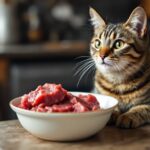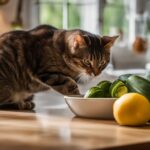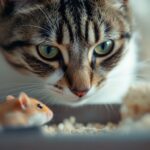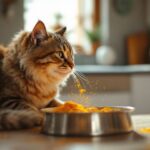Are you wondering if your feline friend can enjoy the same lamb dish you love? Lamb is a nutritious option, packed with protein and important vitamins such as vitamin B6. This blog will guide you on how to safely incorporate lamb into your cat’s carnivorous diet.
Read on to make mealtime exciting for your kitty!
Key Takeaways
- Cats can eat lamb as it is a good source of protein, offering nearly 7 grams per ounce. This helps with weight gain and provides essential nutrients like vitamin B6.
- Lamb should be served in small, manageable portions once or twice a week to avoid high fat intake and ensure a balanced diet alongside other proteins.
- Cooking lamb properly without any seasonings or additives is crucial for cat safety since certain ingredients like garlic and onion can be harmful to them.
- Monitor cats for allergic reactions when introducing lamb into their diet. Symptoms may include itching or digestive upset.
- Excessive consumption of lamb’s fat content may lead to health issues such as obesity, so moderation is key in serving sizes.
Overview of Lamb as a Food Source for Cats
Lamb serves as a good protein source for cats. It can offer essential nutrients that support their carnivorous diet and overall health.
Similarities of Cats and Dogs as Carnivores
Cats and dogs share many similarities as carnivores. Both species thrive on a meat-based diet, requiring animal protein to meet their nutritional needs. They are designed to digest high-protein foods effectively, which is essential for maintaining energy levels.
Lamb serves as an excellent source of protein for cats, with one ounce providing nearly 7 grams. This high-protein option supports cats who need to gain weight while offering various nutrients like vitamin B6 that contribute to a balanced cat food.
Both animals benefit from the nutrients found in lamb compared to other common farmyard proteins. Lamb contains CoQ10, an antioxidant that boosts the immune system in cats. Such vitamins and minerals make lamb not only nutritious but also a well-rounded choice in pet nutrition for those looking to diversify protein sources within a cat’s diet.
Nutritional Value of Lamb
Lamb serves as a nutritious option for cats, offering a good source of animal-based protein. Just one ounce contains nearly 7 grams of protein, making it an excellent choice for those needing to gain weight.
This meat includes essential nutrients like vitamin B6 and the antioxidant CoQ10, which helps boost the immune system in cats. Lamb is also known to have more vitamins and minerals compared to other common farmyard proteins.
A meat-based diet benefits from incorporating lamb due to its balanced nutritional profile. Many cat food manufacturers recognize lamb’s value, using it as a main ingredient in their products.
Cooked, lean meats such as lamb provide essential animal fat that meets cat dietary requirements effectively. Lamb can enhance overall cat nutrition by supplying necessary nutrients while keeping meals exciting and varied.
How Much Lamb Can Cats Eat?
When feeding cats lamb, keep portion sizes small. A few bites can be a nice treat, but it shouldn’t make up a large part of their meals.
Suggested Serving Size
The suggested serving size of lamb for cats should be small and manageable. A good guideline is to offer about one ounce of cooked lamb, which provides nearly 7 grams of protein. This portion can support a cat’s need for animal-based protein while ensuring it fits into a balanced diet.
It’s important to serve lamb in moderation, as excessive amounts may contribute to high fat intake or digestive issues. Regularly including lamb in your cat’s meat-based diet can be beneficial, but be mindful of other proteins like chicken or fish also included in their meals.
Frequency of Feeding
Cats can enjoy lamb in moderation, but frequency matters. Feeding lamb too often may lead to excessive fat intake, which could be harmful. A small serving of cooked lamb once or twice a week is generally sufficient for most cats.
This helps balance their meat-based diet while keeping the benefits of animal-based protein like that found in lamb.
Lamb offers various nutrients and boasts nearly 7 grams of protein per ounce, making it a nutritious option. Serving it occasionally allows your cat to reap its health benefits without overdoing it.
Always ensure that any portion given is cooked properly and free from seasonings or additives that could pose risks to your feline friend.
Risks and Concerns When Feeding Cats Lamb
Feeding cats lamb can pose some risks. High fat content may lead to weight gain or digestive issues. Some cats might also have allergies to lamb, so monitoring for reactions is essential.
Additionally, seasonings and cooking methods can make the meat unhealthy for them.
High Fat Content
Lamb can be high in fat content, which may not be suitable for all cats. This rich source of protein is beneficial for those who need to gain weight, but excessive fat can lead to obesity and other health issues.
Each ounce of lamb provides nearly 7 grams of protein, making it a great option for muscle development. Monitoring portion sizes ensures that your cat receives the nutritious benefits without overindulging in calories from the fat.
It’s essential to serve lamb in moderation while considering how often you include it in their diet.
Allergies to Lamb
Allergies to lamb can occur in some cats, even though it is a nutritious option. Many pet owners may not realize that their cat could be sensitive to specific proteins, including those found in lamb.
Symptoms of allergies might include itching, digestive upset, or other skin issues. Cats requiring a meat-based diet should be watched closely for any adverse reactions when introducing new foods like lamb.
If your cat shows signs of an allergy after consuming lamb, consult a veterinarian for guidance. Understanding how much lamb cats can eat and recognizing the importance of proper preparation will help ensure their diet remains safe and healthy.
Seasonings and Preparation Methods
Seasonings can be harmful to cats, so it’s essential to keep lamb plain. Avoid using salt, garlic, onion, or other spices when preparing lamb for your feline friend. Cooked, lean meats like lamb provide a nutritious option with nearly 7 grams of protein per ounce.
Lamb contributes beneficial nutrients such as vitamin B6 and CoQ10, which support the immune system in cats. To ensure safety during preparation, always cook the meat thoroughly before offering it to your cat.
Raw meat may pose risks; therefore, many experts recommend serving only cooked lamb as part of a balanced diet rich in animal-based protein and nutritious options like beef and poultry.
Conclusion
Cats can enjoy lamb as part of their diet, especially since it’s rich in protein and essential nutrients. Offering lamb in moderation can provide health benefits while ensuring safety.
Always prepare the meat without added seasonings to avoid any risks. With proper handling, lamb can be a tasty and nutritious treat that your feline friend will love!
FAQs
1. Can cats eat lamb as part of their diet?
Yes, cats can eat lamb. It’s a meat-based diet that provides them with the animal-based protein they need.
2. Is it okay for cats to consume other types of meat?
Absolutely! Cats can also enjoy beef, pork, poultry, fish, turkey, venison and rabbit as part of their balanced diet.
3. What about chicken and duck; are these safe for my cat to eat?
Surely! Both chicken and duck are excellent sources of nutrition for your feline friend.
4. Can I feed my cat liver along with other meats?
Indeed you can! Liver is another good source of animal-based protein that is beneficial for your cat’s health.
5. Are there any specific meats I should avoid feeding my cat?
While most meats like lamb or beef are fine for cats to consume in moderation, always consult your vet before introducing new foods into their diet.






